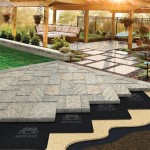Ideas for Landscaping Around Your Patio: Enhancing Outdoor Living
A patio serves as an extension of the home, providing a space for relaxation, entertainment, and enjoying the outdoors. Effective landscaping around a patio significantly enhances its usability and aesthetic appeal, transforming it from a simple paved area into an integrated part of the garden and overall property design. Careful consideration of plant choices, hardscaping elements, and functional features can create a seamless transition between indoor and outdoor spaces, adding value and enjoyment to the home.
Designing the landscaping around a patio requires a strategic approach, considering the architectural style of the house, the surrounding environment, and the desired functionality of the space. Factors such as sun exposure, soil type, and prevailing winds should also be taken into account to ensure the success of the chosen plants and materials. The goal is to create a cohesive and inviting outdoor living area that complements the existing landscape and provides a comfortable and aesthetically pleasing environment.
Creating Defined Zones and Visual Interest
One of the primary goals of patio landscaping is to create distinct zones within the outdoor space. This can be achieved through the strategic placement of plants, hardscaping features, and changes in elevation. Defining zones helps to create a more organized and functional space, providing areas for dining, lounging, and other activities. Visual interest can be added through the use of diverse plant textures, colors, and forms, as well as the incorporation of focal points such as sculptures, water features, or specimen trees.
Hardscaping elements such as low walls, raised planters, and pathways can be used to define the edges of the patio and create a sense of enclosure. Low walls not only provide seating options but also act as a visual barrier, separating the patio from the surrounding landscape. Raised planters can be used to add height and dimension to the landscape, creating a tiered effect that is both visually appealing and functional. Pathways can guide visitors through the garden and towards the patio, creating a sense of anticipation and discovery.
Plant selection is crucial for creating visual interest. Combining plants with different textures, such as the fine foliage of ornamental grasses with the broad leaves of hostas, can add depth and complexity to the landscape. Incorporating plants with varying bloom times ensures that the patio area remains colorful and vibrant throughout the growing season. Consider using plants with interesting foliage colors, such as purple-leaved heucheras or silver-leaved artemisia, to add further visual appeal. The careful layering of plants, with taller shrubs in the background and shorter perennials in the foreground, creates a sense of depth and dimension.
Focal points serve as visual anchors, drawing the eye and creating a sense of drama. A well-placed sculpture can add an artistic element to the landscape, while a bubbling fountain can provide a soothing sound and create a tranquil atmosphere. Specimen trees, such as Japanese maples or flowering dogwoods, can add height and structure to the landscape, creating a focal point that is both beautiful and functional. The key is to choose focal points that complement the overall design of the patio and the surrounding landscape.
The integration of lighting is essential in extending the usability of the patio into the evening hours. String lights can create a festive and inviting atmosphere, while path lights can illuminate walkways and highlight key features in the landscape. Spotlights can be used to accent focal points, such as sculptures or trees, creating a dramatic effect. Low-voltage landscape lighting is an energy-efficient option that can be easily installed and maintained.
Selecting the Right Plants for Your Patio Environment
The success of patio landscaping hinges on the selection of plants that are well-suited to the local climate, soil conditions, and sun exposure. Choosing plants that thrive in the specific environment will minimize maintenance requirements and ensure that the patio remains beautiful and healthy throughout the year. Consider the size and growth habit of the plants, ensuring that they will not outgrow the available space or obstruct views. Native plants are often a good choice, as they are well-adapted to the local environment and require less water and fertilizer than non-native species.
For sunny patios, drought-tolerant plants such as lavender, rosemary, and sedum are excellent choices. These plants thrive in hot, dry conditions and require minimal watering. Ornamental grasses, such as feather reed grass and blue fescue, can add texture and movement to the landscape. Flowering perennials, such as coneflowers and black-eyed Susans, provide a splash of color and attract pollinators. Consider planting these in containers or raised beds for added flexibility and ease of maintenance.
Shady patios require plants that can tolerate low light conditions. Hostas, ferns, and impatiens are popular choices for shady areas. These plants thrive in moist, well-drained soil and provide a lush, green backdrop. Groundcovers, such as creeping Jenny and vinca minor, can be used to fill in bare spots and prevent weed growth. Consider adding pops of color with shade-loving flowering plants, such as begonias and fuchsias. The careful selection of plants can transform a shady patio into a cool and inviting oasis.
Consider the placement of plants in relation to the patio furniture and other features. Taller plants can be used to provide shade and privacy, while shorter plants can be used to soften the edges of the patio. Avoid planting thorny or prickly plants near seating areas or walkways, as they can pose a safety hazard. Fragrant plants, such as jasmine and gardenia, can add a pleasant aroma to the patio area, enhancing the overall sensory experience.
Container gardening is an excellent option for patios, providing flexibility and allowing for easy customization. Containers can be used to grow a wide variety of plants, including flowers, herbs, vegetables, and small trees. Choose containers that are appropriate for the size and type of plants being grown, and ensure that they have adequate drainage. Regular watering and fertilization are essential for maintaining healthy container plants. Moving containers around is a great way to change the look of the patio throughout the year.
Incorporating Practical Features for Enhanced Functionality
Beyond aesthetics, practical features can greatly enhance the functionality of a patio. Incorporating elements such as outdoor kitchens, seating areas, fire pits, and water features can transform the patio into a versatile outdoor living space. The key is to design these features in a way that complements the overall landscape and enhances the usability of the patio.
Outdoor kitchens are becoming increasingly popular, providing a space for cooking and entertaining outdoors. A well-designed outdoor kitchen can include a grill, a sink, a refrigerator, and ample counter space. Consider incorporating storage solutions for cooking utensils and other supplies. The location of the outdoor kitchen should ideally be close to the house for easy access to indoor amenities. A pergola or gazebo can provide shade and protection from the elements, making the outdoor kitchen more comfortable to use.
Seating areas are essential for creating a comfortable and inviting patio. Choose furniture that is both stylish and durable, and that complements the overall design of the landscape. Consider incorporating a mix of seating options, such as lounge chairs, dining tables, and benches, to accommodate different activities. Outdoor rugs can add comfort and style to the seating area, while pillows and cushions can provide additional support and personalization. The arrangement of the seating area should encourage conversation and interaction.
Fire pits provide a focal point and create a cozy atmosphere for evening gatherings. Fire pits can be built-in or portable, and can be fueled by wood, propane, or natural gas. Ensure that the fire pit is located in a safe area, away from flammable materials such as trees and shrubs. Consider adding seating around the fire pit to create a comfortable and inviting space for relaxation. A fire pit can extend the usability of the patio into the cooler months, making it a valuable addition to any outdoor living space.
Water features, such as fountains, ponds, and waterfalls, can add a soothing and tranquil element to the patio. The sound of running water can mask unwanted noise and create a relaxing atmosphere. Water features can also attract wildlife, such as birds and butterflies, adding to the overall enjoyment of the patio. Consider incorporating aquatic plants and fish into the water feature to create a more natural and dynamic environment. Regular maintenance is essential for keeping water features clean and healthy.
The addition of a shade structure, such as a pergola, awning, or umbrella, can provide relief from the sun and heat, making the patio more comfortable to use during the hottest parts of the day. A pergola can be covered with climbing plants, such as wisteria or clematis, to create a natural and beautiful shade canopy. A retractable awning can be adjusted to provide varying levels of shade, depending on the time of day and the weather conditions. A large umbrella can be easily moved around to provide shade where it is needed most. The addition of a shade structure can significantly enhance the usability of the patio during the summer months.
Ultimately, landscaping around a patio is about creating a harmonious blend of aesthetics and functionality. The goal is to transform the patio into an inviting outdoor living space that complements the home and the surrounding landscape. By carefully considering plant choices, hardscaping elements, and practical features, homeowners can create a patio that is both beautiful and functional, providing years of enjoyment.

Backyard Landscaping Ideas Garden Design

Planting Patios How To Grow A Garden Surrounding Patio Gardening Know

Tips On Landscaping Around A Patio Whitehouse

25 Best Inspiration Beautiful Landscaping Around Patio For Amazing Garden Freshouz Home Architecture Decor

55 Ideas For Landscaping Around A Deck Or Patio Hgtv
:max_bytes(150000):strip_icc()/byladyfirewide-31eeadee36fe4b73b6ca21c30a5e6312.jpg?strip=all)
52 Best Backyard Landscaping Ideas

Retaining Wall Photos Courtyard And Fence

Small Space Patio Border Garden Gate

50 Backyard Ideas For A Beautiful Landscape Hgtv

How To Landscape Around Your Deck 4 Great Ideas








